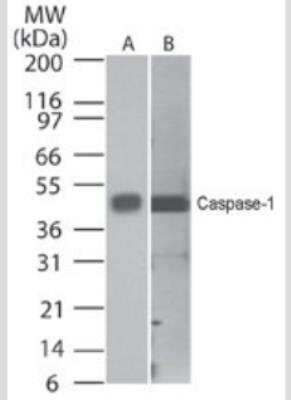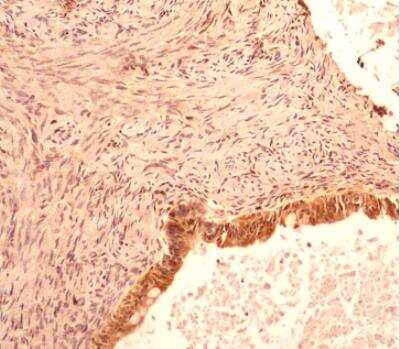Caspase-1 Antibody (14F468) - Azide and BSA Free
Novus Biologicals, part of Bio-Techne | Catalog # NBP2-33230


Conjugate
Catalog #
Forumulation
Catalog #
Key Product Details
Species Reactivity
Human, Mouse, Rat
Applications
Immunohistochemistry, Immunohistochemistry-Paraffin, Simple Western, Western Blot
Label
Unconjugated
Antibody Source
Monoclonal Mouse IgG1 kappa Clone # 14F468
Format
Azide and BSA Free
Concentration
1.0 mg/ml
Product Specifications
Immunogen
Caspase-1 Antibody (14F468) - Azide and BSA Free was developed against a synthetic peptide corresponding to amino acids 371-390 RKVRFSFEQPDGRAQMPTTE of human caspase-1.
Reactivity Notes
Immunogen's sequence similarity with other species: Porcine (85%), Equine (80%), Canine (70%). Rat reactivity reported in scientific literature (PMID: 22133203).
Localization
Cytoplasm, Nucleus
Specificity
Caspase-1 Antibody (14F468) will recognize full-length Caspase-1 and cleaved caspase-1 forms that retain amino acids 371-390 of the Caspase-1 protein.
Clonality
Monoclonal
Host
Mouse
Isotype
IgG1 kappa
Theoretical MW
45.2 kDa.
Disclaimer note: The observed molecular weight of the protein may vary from the listed predicted molecular weight due to post translational modifications, post translation cleavages, relative charges, and other experimental factors.
Disclaimer note: The observed molecular weight of the protein may vary from the listed predicted molecular weight due to post translational modifications, post translation cleavages, relative charges, and other experimental factors.
Scientific Data Images for Caspase-1 Antibody (14F468) - Azide and BSA Free
Western Blot Analysis of Caspase-1 in Infected Mouse BMMs
P. gingivalis and its OMVs differentially induce inflammasome signaling and pyroptosis in murine macrophages. BMM were infected as before (2 h at MOI of 25:1, see Materials and Methods) with viable P. gingivalis (Pg), heat-killed-Pg (HK-Pg), OMVs, or heat-inactivated-OMVs (HI-OMVs) and the activation of inflammasome components in the lysates [or supernatants (sup) where indicated] measured after 24 h by Western blot; beta-actin serves as a loading control throughout. Western blot data are representative of at least three independent experiments. Image collected and cropped by CiteAb from the following publication (https://journal.frontiersin.org/article/10.3389/fcimb.2017.00351/full), licensed under a CC-BY license. Image using the standard format of this product.Immunohistological Staining of Caspase-1 in Paraffin Embedded Human Intestine
Tissue section of human intestine using Caspase-1 antibody (clone 14F468) at 5ug/ml concentration (1:200 dilution). The primary antibody binding to Caspase 1 in cells was detected using HRP conjugated anti-Mouse secondary antibody with DAB reagent, and the sections were further counterstained with hematoxylin for labeling cellular nuclei. This Caspase 1 antibody generated a diffused but specific cytoplasmic staining in columnar epithelia cells of villi, and a few cells depicted nuclear staining also. Only a subset of connective tissue cells in lamina propria depicted positivity (cytoplasmic) for this protein. Image using the standard format of this product.Western Blot Detection of Caspase-1 in Human and Mouse Cell Lysates
Analysis in human HeLa (A) and mouse NIH3T3 lysate probed with Caspase-1 antibody at 0.5 ug/ml and 2 ug/ml, respectively.Applications for Caspase-1 Antibody (14F468) - Azide and BSA Free
Application
Recommended Usage
Immunohistochemistry
1:10 - 1:500
Immunohistochemistry-Paraffin
1:10-1:500
Simple Western
1:50
Western Blot
0.5-2 ug/ml
Application Notes
Staining of formalin-fixed tissues is enhanced by boiling tissue sections in 10 mM sodium citrate buffer, pH 6.0 for 10-20 min followed by cooling at RT for 20 min. In Simple Western only 10-15 uL of the recommended dilution is used per data point.
See Simple Western Antibody Database for Simple Western validation: antibody dilution of 1:50 The observed molecular weight of the protein may vary from the listed predicted molecular weight due to post translational modifications, post translation cleavages, relative charges, and other experimental factors.
See Simple Western Antibody Database for Simple Western validation: antibody dilution of 1:50 The observed molecular weight of the protein may vary from the listed predicted molecular weight due to post translational modifications, post translation cleavages, relative charges, and other experimental factors.
Formulation, Preparation, and Storage
Purification
Protein G purified
Formulation
PBS
Format
Azide and BSA Free
Preservative
No Preservative
Concentration
1.0 mg/ml
Shipping
The product is shipped with polar packs. Upon receipt, store it immediately at the temperature recommended below.
Stability & Storage
Store at 4C short term. Aliquot and store at -20C long term. Avoid freeze-thaw cycles.
Background: Caspase-1
Given the role of IL-1beta in inflammation, it makes sense that many diseases and pathologies have been associated with dysregulation of caspase-1 activation and the inflammasome (3, 4). The inflammasome is a multiprotein complex comprised of Nod-like receptor (NLR) family members and the adapter ASC (apoptosis-associated speck-like protein containing a CARD) which are crucial for capase-1 activation (3-5). For instance, the neuronal apoptosis inhibitory protein (NAIP)/NLRC4 inflammasome has been associated with colorectal cancer, breast cancer, and glioma pathogenesis (5). Caspase-1 activation and mutations in the inflammasome have also been linked to Chron's disease and Alzheimer's disease (4). In addition to immune and inflammatory related disorder, the inflammasome has been linked to metabolic and obesity related disorders including diabetes and cardiovascular disease (6). Finally, caspase-1 deficient mice exhibit enhanced epithelial cell proliferation in the colon, increased tumor formation, and reduced apoptosis (1). A more thorough understanding of the inflammasome-caspase-1 signaling pathway will be important for understanding disease pathology and potential therapeutic development.
Alternative names for caspase-1 includes CASP1, CASP1 nirs variant 1, EC 3.4.22.36, ICE, IL-1 beta-converting enzyme, IL1BC, IL1BCE, IL1B-converstase, interleukin-1 beta convertase, and p45.
References
1. Shalini, S., Dorstyn, L., Dawar, S., & Kumar, S. (2015). Old, new and emerging functions of caspases. Cell death and differentiation. https://doi.org/10.1038/cdd.2014.216
2. Chang, H. Y., & Yang, X. (2000). Proteases for cell suicide: functions and regulation of caspases. Microbiology and molecular biology reviews: MMBR. https://doi.org/10.1128/mmbr.64.4.821-846.2000
3. Vanaja, S. K., Rathinam, V. A., & Fitzgerald, K. A. (2015). Mechanisms of inflammasome activation: recent advances and novel insights. Trends in cell biology. https://doi.org/10.1016/j.tcb.2014.12.009
4. Franchi, L., Eigenbrod, T., Munoz-Planillo, R., & Nunez, G. (2009). The inflammasome: a caspase-1-activation platform that regulates immune responses and disease pathogenesis. Nature immunology. https://doi.org/10.1038/ni.1703
5. Kay, C., Wang, R., Kirkby, M., & Man, S. M. (2020). Molecular mechanisms activating the NAIP-NLRC4 inflammasome: Implications in infectious disease, autoinflammation, and cancer. Immunological reviews. https://doi.org/10.1111/imr.12906
6. Pham, D., Park, P. (2020). Recent insights on modulation of inflammasomes by adipokines: a critical event for the pathogenesis of obesity and metabolism-associated diseases. Archives of Pharmacal Research. https://doi.org/10.1007/s12272-020-01274-7
Alternate Names
CASP1, Caspase1, ICE
Gene Symbol
CASP1
UniProt
Additional Caspase-1 Products
Product Documents for Caspase-1 Antibody (14F468) - Azide and BSA Free
Product Specific Notices for Caspase-1 Antibody (14F468) - Azide and BSA Free
This product is for research use only and is not approved for use in humans or in clinical diagnosis. Primary Antibodies are guaranteed for 1 year from date of receipt.
